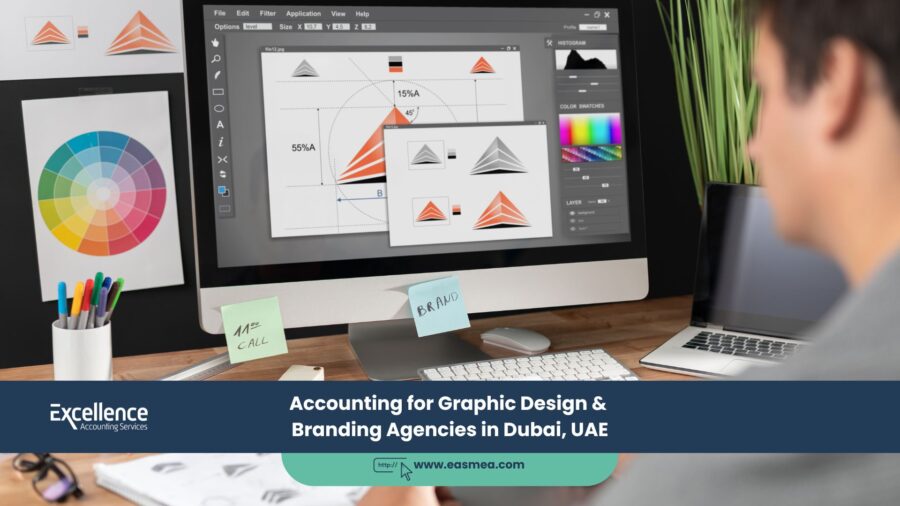In the visually stunning and brand-conscious market of Dubai, graphic design and branding agencies are the creative architects behind the city’s most compelling corporate identities and marketing campaigns. From crafting iconic logos to developing comprehensive brand strategies, these agencies translate business goals into powerful visual language. While creativity is the soul of a design agency, its long-term success and growth are built on a framework of sharp, insightful, and strategic financial management.
Accounting for a graphic design and branding agency in Dubai is a unique challenge that blends project-based finance with the management of intellectual assets. Profitability is not just about the fees you charge; it’s about understanding the true cost of your creative team’s time, managing recurring software costs, and navigating a variety of project-based pricing models. Without a robust accounting system, even the most creatively acclaimed agency can find its profits diminished by unbilled hours and poor cost control.
This definitive guide provides a strategic blueprint for Accounting for Graphic Design & Branding Agencies in Dubai, UAE. We will explore the critical financial practices for the creative industry, from the complexities of job costing and revenue recognition to the proper handling of freelance artist payments. We will also provide clarity on the application of VAT and the new UAE Corporate Tax to design services, ensuring your agency is both compliant and financially strong.
Whether you are a solo freelance designer or a full-service branding agency, this guide will equip you with the financial knowledge to build a resilient and profitable business. We will cover industry best practices, essential financial controls, and the reporting that builds confidence with clients and allows you to invest in your creative future.
Key Takeaways
- Time Tracking is the Key to Profitability: The primary cost of any project is your team’s creative time. Meticulously tracking billable and non-billable hours is essential for accurate job costing and pricing.
- Master Project-Based Pricing Models: Whether you charge by the hour, per project (fixed fee), or on a monthly retainer, your accounting system must be able to track costs and recognize revenue correctly for each model.
- Software is a Major Operating Cost: Recurring subscriptions for design software (e.g., Adobe Creative Cloud) are a significant, deductible business expense that must be properly budgeted and tracked.
- Manage Freelancer Payments Correctly: Payments to freelance designers or copywriters are a direct cost of a project and must be tracked accordingly, with proper invoicing and documentation.
- VAT and Corporate Tax Compliance: Design and branding services are subject to 5% VAT, and your agency’s profits are subject to 9% Corporate Tax. Compliant accounting is a legal necessity.
The Financial Anatomy of a Design & Branding Agency
A design and branding agency is a professional service business whose primary product is creativity and intellectual property. The business model is almost entirely project-based, revolving around discrete client engagements. Financial success depends on the ability to price these creative projects profitably, manage the creative process efficiently, and maintain a steady pipeline of new business.
Operating in Dubai’s competitive creative landscape, which is supported by hubs like the Dubai Design District (d3), means competing with global talent. This makes efficient operations and a strong financial footing more important than ever.
Core Principles of Accounting for Graphic Design & Branding Agencies in Dubai, UAE
The fundamental principle of accounting for graphic design & branding agencies in Dubai, UAE, is the accurate tracking and allocation of your most valuable and finite resource: your team’s time. Every hour spent on a project, whether by a designer, a strategist, or an account manager, is a direct cost. Your accounting system must be able to capture this cost and measure it against the revenue for each project to determine true profitability.
The Heart of the Matter: Job Costing and Time Tracking
You cannot know if a project was profitable unless you know exactly what it cost to produce. For a design agency, the biggest cost is always labor. Therefore, a robust time-tracking system is not optional; it is essential. Every team member should track their time against specific projects and tasks. This data is the foundation of your job costing.
The cost of a project includes:
- Direct Labor: The salary cost of your team for the exact hours they spent on the project.
- Direct Costs: Any out-of-pocket expenses for the project, such as stock photography licenses, printing for proofs, or payments to freelance collaborators.
- Overhead Allocation: A share of your agency’s fixed costs (rent, software subscriptions, admin salaries) allocated to the project, often based on the number of hours worked.
In a creative agency, time isn’t just money; it’s the raw material of your product. If you’re not accounting for it, you’re giving away your inventory for free.
By subtracting these total costs from the project fee, you get the gross profit for that job. This analysis is vital for understanding which types of projects and clients are most profitable, helping you to refine your pricing and focus your sales efforts. A professional bookkeeping service can be crucial in setting up this level of detailed financial tracking.
A Closer Look at Accounting for Graphic Design & Branding Agencies in Dubai, UAE
Profitability in the creative field requires a disciplined approach to pricing and financial management that supports, rather than stifles, the creative process. This means having clear systems for billing, expense management, and revenue recognition.
Managing Different Pricing Models
Design agencies use various pricing models, and your accounting system must accommodate them all:
- Hourly Billing: The simplest model. You track your hours and bill the client at an agreed-upon rate. Revenue is recognized as the hours are worked.
- Fixed-Fee Projects: You quote a single price for a defined scope of work. This is preferred by clients but carries risk for the agency if the project takes longer than estimated. Revenue should be recognized over the project’s life, often using the percentage-of-completion method.
- Monthly Retainers: A client pays a fixed monthly fee for ongoing design support. Revenue is recognized each month as the service is provided. It’s crucial to track the hours spent on retainer clients to ensure they remain profitable and don’t suffer from “scope creep.”
Accounting for Software and Freelancer Costs
Your agency’s primary tools are software subscriptions. The monthly or annual fees for the Adobe Creative Cloud, project management tools, font libraries, and stock photo services are a significant and recurring operating expense. These should be tracked in a specific “Software & Subscriptions” expense account for clear visibility.
| Expense Type | Description | Accounting Treatment |
|---|---|---|
| Software Subscriptions | Monthly/annual fees for Adobe CC, Figma, etc. | Recorded as a regular operating expense. |
| Freelancer Payments | Fees paid to external designers, copywriters, or developers for a specific project. | Treated as a direct cost of that project (part of its Cost of Goods Sold). |
| Stock Photo Licenses | Cost of purchasing images or fonts for a specific client project. | Billed back to the client as a reimbursable expense or included as a direct project cost. |
When you hire a freelancer for a specific project, their fee is not a general overhead. It is a direct cost of that project and should be allocated to that project’s job cost sheet. This ensures you are accurately measuring the project’s true profitability. Proper documentation, including a contract and invoice from the freelancer, is essential for your own records and tax purposes.
Navigating Tax and Compliance in Dubai
A professional design and branding agency in Dubai must be fully compliant with the UAE’s tax regulations. For the most authoritative guidance, you should always refer to the official website of the Federal Tax Authority (FTA).
VAT on Design Services
The supply of graphic design, branding, and other creative consultancy services in the UAE is subject to the standard 5% rate of VAT. You must issue tax-compliant invoices to your clients that clearly show the 5% VAT charge on your fees. If you provide services to international clients, the VAT treatment can be complex and may be zero-rated depending on the specifics of the service and the client’s location. Professional tax advice is recommended for cross-border transactions. Our specialized VAT services can provide essential clarity.
Corporate Tax for Creative Agencies
Your agency will be subject to the 9% UAE Corporate Tax on its annual taxable profits exceeding AED 375,000. Your taxable profit is your total revenue minus your deductible operating expenses. This includes staff salaries, freelancer costs, software subscriptions, rent, and marketing. The accuracy of your project costing and revenue recognition policies will directly impact your taxable profit. Maintaining complete records for every transaction is mandatory. Professional corporate tax services are vital for ensuring compliance.
What Excellence Accounting Services Can Offer
At Excellence Accounting Services (EAS), we have a passion for helping creative businesses thrive. We understand the unique financial challenges of design and branding agencies, from the importance of time tracking to the management of project-based finances. We offer specialized accounting services designed to provide the financial clarity and strategic support your agency needs.
Our specialized offerings for creative agencies include:
- Project Costing and Profitability Analysis: We help you implement systems to track time and costs for every project, giving you clear insights into profitability by client, project type, and service line.
- Revenue Recognition for Creative Services: We ensure your revenue from retainers and fixed-fee projects is recognized correctly in line with IFRS 15.
- Cash Flow Management for Agencies: We provide detailed cash flow forecasting to help you manage the financial peaks and troughs of project-based work.
- VAT and Corporate Tax Compliance: Our tax experts will manage all your FTA filings, ensuring you are fully compliant with the rules for professional services.
- Virtual CFO Services: Get high-level strategic guidance on pricing strategy, agency profitability, and growth planning. For more details, see our Virtual CFO services.
By partnering with EAS, you gain a financial team that understands your creative world. We handle the numbers so you can focus on creating amazing work.
Frequently Asked Questions (FAQs)
A “bottom-up” calculation is essential. First, calculate the direct hourly cost of an employee (their annual salary and benefits divided by the number of available work hours in a year). Then, calculate your agency’s hourly overhead rate (total annual overheads like rent and software divided by the total available work hours of all creative staff). Add the employee’s direct cost per hour to the overhead rate per hour to get your break-even cost. Finally, add your desired profit margin (e.g., 30-50%) to arrive at your final billable hourly rate.
This is great for cash flow. When you receive the payment, the full amount is recorded as a liability on your balance sheet under “Deferred Revenue.” You have an obligation to provide services for the next six months. Each month, you will then make an accounting entry to recognize one-sixth of the total payment as revenue on your income statement, while simultaneously reducing the deferred revenue liability by that amount. This correctly matches your revenue to your service delivery.
This is a “reimbursable expense” or a direct project cost. The best practice is to bill this cost directly back to the client as a separate line item on your invoice. When you purchase the license, you should record it as a receivable from the client (e.g., “Client Costs Advanced”). This way, it doesn’t hit your own expense account. If you decide to absorb the cost as part of your project fee, then it should be allocated as a direct cost on the project’s job cost sheet.
Yes. Your subscriptions for essential design software are a necessary cost of doing business. As such, the full cost of your Adobe CC, Figma, Sketch, or other software subscriptions is fully deductible as a business expense when calculating your taxable profit for UAE Corporate Tax purposes.
Generally, no. When you provide professional consultancy services to a business client that is located and consuming the service outside the GCC, the service is considered an export and is zero-rated for VAT. You would not charge 5% VAT on your invoice. However, you must retain proof that your client is based outside the GCC (e.g., their business registration documents) to justify the zero-rating to the FTA.
Scope creep is the silent killer of fixed-fee projects. It’s when a client continually asks for “just one more little change” or adds small requests that were not in the original scope of work. Each small request adds unbilled hours from your team, and these hours quickly accumulate, destroying the project’s profit margin. The only defense is a very clear, detailed scope of work in your contract and a disciplined process for identifying out-of-scope requests and issuing a “change order” with a quote for the additional work before you begin it.
WIP represents the value of the work (billable hours) your team has completed but has not yet been invoiced to a client. It is a key current asset on your agency’s balance sheet. For example, if you have done AED 20,000 worth of work on a project but your next milestone invoice isn’t for another month, you have AED 20,000 in WIP. Tracking WIP is crucial for understanding your true financial position and for ensuring that all completed work is eventually invoiced in a timely manner.
Your historical project data is your most valuable pricing tool. After you have accurately tracked the time and costs for dozens of projects, you can analyze the data to find the average actual cost for a “logo design project” or a “brand guidelines document.” This allows you to move from guessing your prices to a data-driven approach. You will know your break-even cost and can apply a confident profit margin, ensuring every new project you quote is profitable.
While not always legally required for smaller firms, an independent audit provides a high level of credibility. If you are pitching for large contracts with major corporate or government clients, they may require audited financial statements as part of their vendor due diligence. It demonstrates that your agency is financially stable and well-managed. If you ever plan to seek investment or sell your agency, audited financials are non-negotiable.
Conclusion: Designing a Profitable Creative Business
In the vibrant creative industry of Dubai, a great portfolio can open doors, but a strong financial foundation is what builds a lasting business. For graphic design and branding agencies, a disciplined and strategic approach to accounting is the essential framework that supports and enables creativity. It transforms your creative output into sustainable profit.
By mastering the art of project costing, managing your revenue streams with precision, and maintaining unwavering compliance with the UAE’s tax laws, you build an agency that is as smart as it is creative. This financial clarity empowers you to price your work with confidence, invest in your team’s growth, and build a powerful brand that is recognized for both its creative excellence and its professional integrity.
From Pixel to Profit.
Let Excellence Accounting Services provide the specialized financial management and industry insight your creative agency needs to succeed in Dubai.




